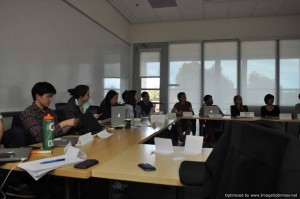By Phil Sandwell, Research postgraduate, Department of Physics and Grantham Institute for Climate Change
This March, six Imperial students travelled to Palo Alto, California, to work with Stanford University students on the innovation stream of the New Climate Economy.
The Global Commission on the Economy and Climate was established to investigate the economic benefits and costs associated with climate change mitigation and adaptation. The flagship project of this is the New Climate Economy, a worldwide collaboration of internationally renowned research institutions. One such stream, focusing on innovation, was spearheaded by Stanford University and the Grantham Institute at Imperial College London.
The aim of this part of the project was to analyse how disruptive technologies, techniques or methods could develop, overtake their incumbent (and generally environmentally damaging) predecessors and mitigate greenhouse gas emissions. These ranged from carbon capture and storage to 3D printing, with my focus being concentrated photovoltaics (CPV).
Beginning in January, we held weekly video conferences with the two Stanford professors facilitating the course. Using their guidance and experience, we established the current limitations of our chosen technologies, how they are likely to advance and the conditions under which their development can be accelerated.
After travelling to Palo Alto, we were divided into groups with the Stanford students based on the themes of our research, for example electric vehicles and car sharing. We then integrated our findings, investigating the synergies and similar themes, and together built models to quantify the potential for greenhouse gas emissions reduction and how it could become achievable.
My research led to the conclusion that CPV can become economically competitive with the most common solar technology, flat-‐plate crystalline silicon cells, in the near future. Given the correct conditions being met (for example the cost per Watt continuing to decline as currently projected) CPV would compare favourably in regions with high direct normal irradiance, such as the Atacama Desert in Chile, the Australian outback and South Africa. One possible application of CPV would be supplying these countries’ mining industries, displacing their current fossil fuel-‐intensive electricity generation and providing an environmentally responsible alternative – with even less embedded carbon and energy than silicon cells.
This project was a valuable addition to my PhD project, the focus of which is to investigate how several different photovoltaic technologies can mitigate greenhouse gas emissions. Collaborating on this project introduced me to interesting new ways of approaching my work, as well as identifying parallels between my research and that of others in the field of renewable energy technology.

